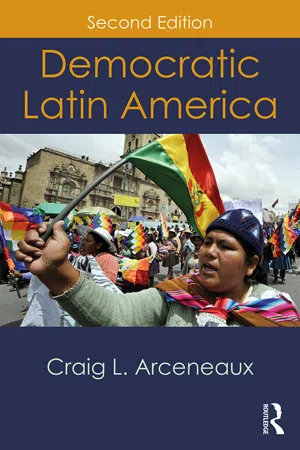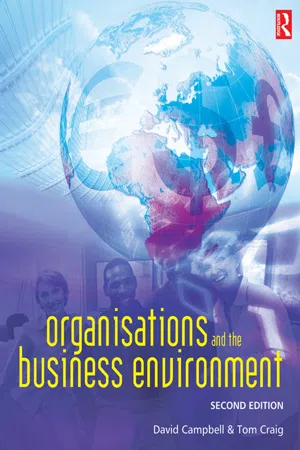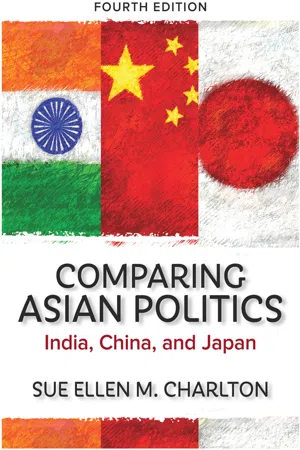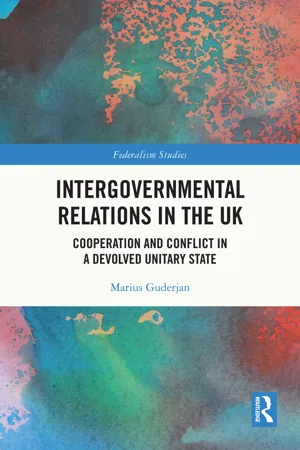Politics & International Relations
Unitary Government
A unitary government is a system in which all political power is concentrated at the national level, with subnational entities having only the powers that the central government chooses to delegate to them. This type of government is characterized by a strong central authority and uniform laws and policies that apply throughout the country. Examples of unitary governments include France and Japan.
Written by Perlego with AI-assistance
Related key terms
5 Key excerpts on "Unitary Government"
- Herbert M. Levine(Author)
- 2015(Publication Date)
- Routledge(Publisher)
Federalism can be defined as a type of political system in which significant governmental powers are possessed by both a national government and a number of regional governments. The regional governments have jurisdictions over smaller geographical areas and fewer people than the nation as a whole. The constitution of such a political system need not, although it may, spell out in specific language the precise powers that each level of government possesses. Nor does it necessarily have to prescribe an equal amount of power for the federal system’s national and regional components. In fact, it can be argued that the distribution of powers between the levels can largely be left to the determination of the workings of the political process and to the people’s elected representatives. From a practical standpoint, how ever, for a federal system to endure for an extended period of time, it is probably necessary that neither of the two levels of government have the power to abolish the other. The constitution should also provide ways in which the regional governments, as separate political entities, can participate in the political process.What Is a Unitary System?
In a unitary political system governmental power is concentrated at the national level. Regional and local governments may exist, but whatever powers they possess are given to them by the national government and are exercised at the forbearance of that government. Thus, the central government at its discretion may enlarge or reduce the powers of its political subdivisions. Frequently in unitary systems the lower-level governments serve primarily as administrative arms of institutions that wield power nationally. They put into effect or implement the policy decisions that are made by the nation’s political leaders. This is not to say that regional politicians or even bureaucrats may not have an influence on public policy through party or administrative channels, but the locus of ultimate political power or sovereignty is clearly at the national level.There is a tendency on the part of many Americans, because of our two hundred years of experience with a federal system, to associate federalism with political democracy and Unitarian systems with authoritarian or dictatorial governments. Such is not the case. A unitary distribution of governmental powers is completely compatible with political democracy as long as the system manifests the principles traditionally associated with democratic government: majority rule, popular sovereignty, and free elections. Great Britain is certainly a democracy; indeed a plausible argument can be made that in some ways it is more democratic than our own system, but it is also unitary—with power concentrated in national governmental institutions and leaders.- eBook - ePub
- Craig L. Arceneaux(Author)
- 2017(Publication Date)
- Routledge(Publisher)
unitary regime, final authority in all policy areas rests in the national government. A unitary regime may allocate power to a regional government, but unlike in the federal regime, such authority can be legally retracted.The Division of Power in a Federal SystemFederalism entails a rather common division of labor in most countries. Foremost, only the national government holds international sovereignty and the unqualified right to enter into international agreements with other countries. Subnational units enjoy sovereignty, but only in respect to each other and the central government (Gibson, 2004, pp. 5–6). To support its role in the global arena, national governments usually retain primary competencies over matters of defense, and take charge of economic planning. Lower levels of government typically focus on social affairs such as health, education, welfare, and cultural programs, as well as the maintenance of law and order.Normally, the constitution will specify these exclusive competencies, but it may also recognize inevitable overlaps by detailing concurrent powers. Sometimes the constitution sets out concurrent powers such that the national government drafts general guidelines, and leaves it to the subnational governments to accommodate their own interests as they fill in the details. Article 24 of the Constitution of Brazil lists a number of concur-rent powers, such as the protection of historical and cultural monuments, court procedures, social security, and education, and then notes, “within the confines of concurrent legislation, the power of the federal government is limited to establishing general guidelines.”And to ensure an exhaustive allocation of powers, constitutions will normally refer to residual powers, or those powers not expressly mentioned. Most countries assign residual powers to the subnational governments. However, the development of implied powers - eBook - ePub
- Tom Craig, David Campbell(Authors)
- 2012(Publication Date)
- Routledge(Publisher)
The fact is that the needs of communities vary across the country and by having a local layer of government; such differences can be accounted for. Unitary and federal local government The constitutional basis of local government varies greatly depending upon whether the state operates a unitary or a federal constitution. A federal system is operated in many democratic states including Germany and the USA. A federation of any kind is an agglomeration of independent bodies that have chosen to merge together. In doing so, they allow the federal government certain powers but retain some for themselves. The federal government does not have the right to overrule individual states in matters which are of local concern. The federal government is therefore a ‘servant’ of local government and not the other way round. In the USA, for example, the federal government in Washington, headed by the president with two legislative houses (the House of Representatives and the Senate), is responsible for economic policy, defence, foreign policy and other areas which are best dealt with at the national level. The individual ‘states’, headed by a state governor, retain responsibility for, among other things, education, policing and some local judicial matters (e.g. some states have the death penalty whilst others have not). A unitary local authority system is the converse of the above. According to the constitution of a unitary state, central government exercises, more or less, total executive power over local government organisation. Local authorities in a unitary state must act according to the frameworks set for them by central government. From time to time, central government amends the responsibilities and powers of local government. Over recent years, central UK government has restructured local government by scrapping some authorities whilst instituting others - eBook - ePub
Comparing Asian Politics
India, China, and Japan
- Sue Ellen M. Charlton(Author)
- 2018(Publication Date)
- Routledge(Publisher)
In theory, the distinction between federal and unitary systems is clear. In practice, the distinction is often murky, even messy. Constitutions typically list powers belonging to the central government and regional governments and may also enumerate shared jurisdictions. But dynamic socioeconomic conditions, along with shifting political values and judicial interpretations, influence the evolution of these jurisdictions in ways unforeseen by the drafters of the constitutions. This has happened in Canada and the United States as well as in India.Evolution in federal systems has been matched by changes in unitary systems, where contemporary history provides examples of national governments attempting to centralize control over their country during some periods but decentralizing at others, or they may centralize in some spheres of activity (such as economic policy) but decentralize in others (social policy). Political and economic conditions often breed as many stresses in unitary systems as they do in federal systems. Such stresses are evident in China, for example, where economic reform policies have included substantial decentralization of policy-making and the introduction by the 1990s of what some scholars have called “market-preserving federalism” or “de facto federalism.”2Level-of-government relationships in India are especially complex. The national government, also known as the Centre or Union, has constitutional powers superior to those of the regional units, called states. The emergency powers and President’s Rule examined in Chapter 9 are examples of the ultimate authority of the Union government. But states have become more important for a variety of reasons, creating tensions between the levels of government. It is to these dynamics that we turn next.(Dis)unity in the Indian Federation
To better understand the countervailing tendencies in Indian federalism, we need to review how India’s Constitution designates the division of powers between the central government and the states. As explained in Chapter 8 - eBook - ePub
Intergovernmental Relations in the UK
Cooperation and Conflict in a Devolved Unitary State
- Marius Guderjan(Author)
- 2023(Publication Date)
- Routledge(Publisher)
McEwen and Petersohn 2015 , 195–196).When New Labour introduced the devolved legislatures, the same party was in government in Westminster, Scotland and Wales, and intergovernmental business was largely channelled through intra-party channels. After 2007, when the Scottish National Party (SNP ) came to power in Scotland and in 2010 the Conservative Party won the UK elections, intergovernmental relations had to turn to extra-party engagements. Although there was no urgent need to work together and manage policy divergence, as more competences were devolved, their allocation across different levels has in practice often become blurred (Cairney 2011 , 87–88). This has created challenges for the coordination of policies, as well as ongoing conflict over responsibilities. The UK's withdrawal from the European Union (EU) has triggered further constitutional tensions exacerbated by the repatriation of powers to the UK. The different positions towards EU membership have severely constrained the relationships between the governments, which were at a low when this study was conducted.4 Taking away the EU's regulatory and governance framework, in which the devolution settlement unfolded over the course of two decades, has not only exposed the weaknesses of the light-weight intergovernmental architecture but has made the representation of territorial interests at UK level ever more relevant (cf. Hunt and Minto 2017 ). The volatility of the UK's devolution process stands in stark contrast to the relatively stable arrangements of federal political systems and has over time threatened the British Union. The cultivation of different nationalisms, which have in the past been reconciled under a common British identity, is most clearly reflected in the Scottish secessionist movement. But public support for Welsh independence too has grown considerably, particularly since the 2019 General Election and the outbreak of the COVID-19 pandemic (Paun and Hall 2021 ). The Welsh Labour-led Government, which unlike the Scottish Government advocates staying part of the UK, has repeatedly expressed its doubts about the sustainability of the Union without more federal-like provisions.5
Index pages curate the most relevant extracts from our library of academic textbooks. They’ve been created using an in-house natural language model (NLM), each adding context and meaning to key research topics.




